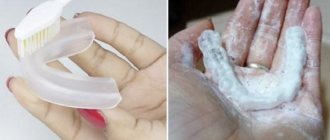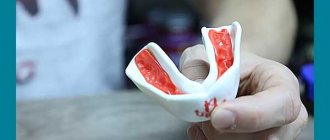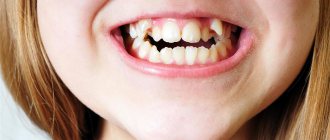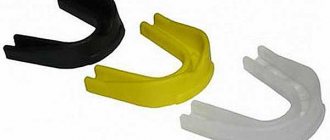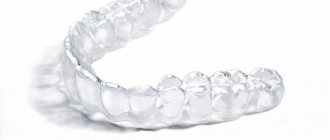A mouthguard, or mouthguard, is a removable structure for teeth in the form of a transparent lining made of silicone or polyurethane. In addition to sports, where it is necessary for protection against mechanical injuries, it is widely used:
· for teeth whitening;
· to straighten teeth;
· to consolidate the results of treatment after removing the braces;
· to correct the bite;
· to prevent enamel abrasion during bruxism.
Depending on their purpose, mouth guards vary in shape and material.
Types of mouth guards and their features
· Standard mouthguards. They are mass produced using one template, so they are not able to take into account the individual characteristics of each patient’s dentition. The material used is polyvinyl chloride (currently banned in EU countries), rubber or plastic. Their advantages are low price and the possibility of immediate use. The design has many more disadvantages. It may have an unpleasant chemical taste and odor, and may not adhere tightly to the teeth. In addition, many patients report severe discomfort when wearing.
· Thermoplastic mouthguards. Made from silicone with special additives, which becomes very soft when exposed to hot water. In this form, the mouth guard is put on the teeth and the material is allowed to cool. As a result, it takes the desired shape, quite accurately repeating the features of the dentition. But still, a thermoplastic mouthguard does not always fit perfectly to the teeth. Most often, it is used as a retainer to consolidate treatment results achieved with another orthodontic design.
· Individual mouthguards. The best option for correcting the bite and straightening the dentition. These mouth guards are made from individual impressions using 3D modeling. Thanks to the thermoplastic material and the vacuum technologies used, this design most accurately replicates the features of the dentition.
Where can I buy sports mouthguards?
Standard and thermoplastic mouth guards are available at many sporting goods stores.
And in order to become the happy owner of a personal protective device, you need to contact a dental clinic. Surprised? In fact, the explanation for this need is quite simple. Individual mouthguards are made using personal impressions of the athlete’s teeth, gums and lip frenulum, which can only be made correctly and efficiently in a dentist’s office. These impressions are then sent to the dental laboratory and within a few days the protection will be ready. Typically, the process of producing a mouthguard using layer-by-layer technology takes no more than a week. A second visit to the doctor will only be required to try on and pick up the device, which, although it takes a toll on the wallet, protects the health and aesthetics of the athletes’ smile.
What types of custom mouthguards are there?
Individual mouth guards can be worn by adults and children starting from 12 years of age.
· Aligners. Used to straighten teeth. They are worn for at least 22 hours a day, removing them only before meals and during oral hygiene.
· Trainers. They are worn only at night and for a few hours during the day. Used primarily to correct bites.
· Retainers. They are worn around the clock for six months to consolidate the results of treatment after removing braces.
How to choose the right and popular brands
Features of mouth guards from different manufacturers.
- Everlast is the market leader in thermoplastic linings that provide superior oral protection. The brand's products are recommended for both beginners and experienced athletes. Mouthguards are made of plastic, EVA and EverGel technology. Country of origin: China.
- Venum - this brand's onlays are made of Nextfit Gel Frame material, have a low rise and fit the teeth perfectly. The flexibility and comfort of the two-layer system is successfully combined with the absorption of impact forces. Country of origin: Taiwan.
- Opro Gold Level UFC - the manufacturer's mouthguards are suitable for people who wear braces and dental plates. The pads are made of three-layer polymer material, are easy to install in the mouth, and are tasteless and odorless. Country of origin: Great Britain.
- Paffen-Sport presents single-layer mouth guards on the market, recommended for children and adults involved in non-professional sports. They are made of plastic and have a mint flavor. Country of origin: Pakistan.
- Flamma - mouth guards from this manufacturer have a double-sided shape, that is, they protect both jaws at the same time. They are made of high-strength rubber using two-layer technology. Country of origin: China.
Indications for wearing individual mouth guards
· Bite correction. Currently, mouthguards are an alternative to the braces system, which is gradually losing its position, giving way to these orthodontic structures made of silicone. Mouthguards are used when there is too much crowding of the dentition or, conversely, excessively wide interdental spaces. They help to gently correct bites that have been disrupted due to jaw injury or missing teeth. The design is effective against dental units that have moved to the side or relative to their axis.
· Bruxism. When grinding teeth, silicone splints save the enamel from abrasion. Mouth guards prevent the jaws from closing completely and help relax spasmed muscles. They are made individually, mainly for one jaw. But there are cases when double-jaw overlays are necessary.
· Teeth whitening. A brightening gel is placed in a special tray. They wear it for several hours (more exact dates should be discussed with your doctor). The advantages of such whitening are the relatively low cost of the procedure and the ability to carry it out at home at a convenient time.
· Protection of teeth and soft tissues. It is necessary for those who are actively involved in sports or love extreme recreation.
Is it possible to practice boxing with braces?
With boxing the situation is more complicated. It's no secret that boxers traditionally enter the ring wearing special protective mouthguards. Therefore, theoretically, the medical Olympic reference book allows for the possibility of an athlete participating in competitions wearing braces. It is emphasized that the treating orthodontist must give his consent to this, and the jaws must be protected by a professionally made individual mouthguard that exactly matches the braces installed on the teeth.
In practice, each boxer must find the answer to this question himself, deciding what is more important for him at this stage - aesthetics or athletic achievements.
Disadvantages of custom mouth guards
· Price. This is the most expensive type of mouthguards, since they are made individually using computer modeling. During the production process, high-quality biocompatible material that does not cause allergies is used.
· Long production time. Unlike standard mouthguards, which can be put on right away, a custom design takes some time to create.
General overview
From a technical point of view, a mouthguard is a removable structure used in orthodontics, the purpose of which is to correct small bite defects and abnormal position of teeth, distribute the load from the temporomandibular joint, and also record the results achieved while wearing braces. The device, made of biologically compatible material, is durable and elastic, and does not cause discomfort while wearing.
A sports mouthguard for teeth is one of the varieties of such overlays, popular among stuntmen and professional athletes. Silicone protection prevents maxillofacial damage while maintaining joint functionality. Wearing a mouthguard is recommended not only by dentists, but also by trainers.
The process of making a custom mouth guard
The production process of individual mouthguards takes place in several stages.
· Taking impressions. Based on them, a working model is made in the laboratory, scanned and a three-dimensional image is displayed on a computer.
· Development of a treatment plan. At this stage, the doctor, using a special program, predicts the results of treatment and, based on them, determines how many individual trays the patient will need.
· Manufacturing of structures. In accordance with the predicted results of treatment, a set of individual mouth guards is made for the patient. They are packaged in a special container and sent to the doctor.
The patient puts on the first mouthguard at the appointment. The doctor gives him recommendations and sets the next date for his visit.
Varieties
Modern dental clinics specializing in the manufacture of sports mouthguards offer four types of models, each of which is characterized by specific features:
- Universal pads. Designs of serial production, providing for the presence in the line of three or more basic sizes, formed according to a template. Such models cannot be manually adjusted, and despite their low cost, they are not particularly popular, which is caused by an uncomfortable fit and insufficiently tight contact during use;
- Individual mouthguards. The design, manufactured in a dental laboratory on the basis of diagnostics, takes into account the features of the anatomical structure of the jaw, which guarantees ease of use. In addition, personal models are often made taking into account the wishes of the athlete, which means applying the color scheme corresponding to the club affiliation to the material;
- Molded mouthguards. Technologically reminiscent of a template variation, these protective pads are made of rubber and rubber, which significantly reduces the comfort of their use, and also contributes to problems with breathing and speech function;
- Thermoplastic inserts - the use of polymer materials that soften under the influence of heat treatment allows you to create an anatomically accurate mouthguard that ensures trouble-free wearing and normalizes the respiratory process even under increased loads. Such models are popular among professionals, but are characterized by high cost and short service life.
When choosing optimal protection, you should focus not only on budget, but also on functional requirements. For training and activities at the amateur level, inexpensive designs are quite suitable, while for professional athletes the best solution would be to order an individual reinforced mouth guard.
Custom sports mouth guards
Sports mouthguards are necessary to protect teeth, as well as hard and soft tissues of the face from mechanical injuries. They optimally distribute the load resulting from blows, and thereby prevent serious injuries - jaw fractures, displacement of the mandibular joint, damage to the cervical spine, concussion, etc.
Like mouthguards for orthodontic treatment, they come in three types - standard, thermoplastic and customized.
Despite the fact that standard mouthguards are produced in three sizes, they still cannot fully protect the athlete’s dental system, since they have many disadvantages. Therefore, dentists are unanimous in their opinion: standard mouthguards are useless, since they do not take into account the individual characteristics of the oral cavity.
Thermoplastic mouthguards are not much better than standard models. They are poorly fixed and, moreover, are not strong enough to become full-fledged protection. Due to increased loads, such material will quickly begin to deform and collapse.
The ideal way out of this situation is individual mouthguards. They accurately repeat the relief of the oral cavity, as well as all the anatomical features of the jaw and dentition, due to which maximum protection will be ensured. At the same time, a custom-made sports mouth guard is very comfortable to wear. It will not impede breathing or diction.
There are several types of sports mouth guards:
· single-layer (light) – intended for children, youth, as well as for fitness classes;
· double-layer (semi-professional) – used for non-contact sports;
· three-layer (professional) – necessary in sports with direct contact;
· hard three-layer (elite) – suitable for all sports.
In addition, there is another model of sports mouthguards - for braces. It protects the structure, teeth and soft tissues from mechanical damage and injury. Thanks to her, you don’t have to give up activities due to the need for orthodontic treatment or the use of braces, preferring sports.
Professional sports and braces: compatibility of the incompatible
Statistics show that teeth, and therefore the braces on them, can be injured not only by doing boxing and martial arts or playing hockey, rugby, handball and American football. The list of potentially dangerous sports included skating, basketball, athletics and even tennis. But this did not stop world sports stars from correcting their dentition with orthodontic systems.
Tennis players Anna Kournikova, sisters Williams and Martina Hingis, and basketball stars David Robinson, Sam Bowie and Devon White have had their teeth fixed with braces. Even the famous Carl Lewis, an American track and field athlete who once received the title of the fastest man in the Universe, appeared in the photo wearing braces. When developing a treatment plan for them, orthodontists took into account the fairly high risk of injury to the face and jaws and selected the appropriate design option.
Caring for your custom mouthguard
Caring for the mouthguard is very simple. Like teeth, it is enough to brush it twice a day with a soft toothbrush, using toothpaste without abrasive particles.
Before eating, the structure must be removed, and before putting it back on, rinse with cool water.
The mouthguard should be stored in a glass of water or in a solution for rinsing teeth.
Otherwise, the material may begin to dry out and the tire will become deformed.
Sports mouthguards are stored in special cases with holes for air circulation. When caring, use special soluble tablets for dentures.
The most important thing is to avoid exposure to high temperatures, and also to protect the structure from mechanical damage. If inspection reveals signs of wear or deformation, the mouth guard should not be used. It needs to be replaced.
At each visit to the dentist, the patient should bring a mouth guard with him.
What kind of braces do we install?
- Installing a classic internal apparatus or innovative Incognito lingual braces allows you to maintain your usual training regimen. They are located on the inside of the jaws, do not injure the mucous membrane of the lips, cheeks and tongue and have proven themselves well in contact martial arts.
- If the bite is corrected by the vestibular apparatus, located externally and visible to others, the athlete will be offered a special orthodontic mouthguard with cells in which clasps glued to the teeth will be placed. It will not only protect braces and teeth from possible sports injuries, but will also protect the mucous membrane from injury by protruding elements of braces.
The main thing you need to know: the proper degree of protection will be provided only by an individually made mouthguard, and not by a standard, more affordable one.
Cost of individual mouthguards
The price of individual mouthguards, both sports and medical, is much higher than similar designs made according to the same template in the factory. It depends on the material and manufacturing method, as well as the manufacturing company.
(in the case when a custom design is produced abroad).
Orthodontic treatment using custom aligners will cost even more because it has many components, the main one being its duration. It depends on the complexity of the clinical case. The more difficult it is to correct the pathology, the more aligners and visits to the doctor will be needed, which will ultimately affect the final cost of therapy.
An alternative option is the innovative Invisalign system.
Is it possible to do martial arts with braces?
In this case, Invisalign aligners may be a more suitable option. A mouth guard can be offered to athletes with less pronounced bite defects. It is made from a transparent elastic composite using a scanned image of the jaws and bite using IT technologies. The one-piece cast design allows for quick and effective tooth alignment and is an ideal choice for athletic patients.
How much does it cost to install mouth guards?
The total cost of bite correction will depend on the number of trays used. The treatment plan is drawn up by the doctor after diagnosis, which includes:
- panoramic shot of the jaws;
- teleroentgenogram of the skull;
- making models of jaws from casts.
The more significant the deviations from the normal position of the teeth, the longer the treatment period will be. The doctor will calculate the advisability of using mouth guards and, in case of serious malocclusions, will offer alternative options - the use of braces and orthodontic devices. The most popular aligners for correcting bites are from the Invisalign brand from the international manufacturer Align Technology.
Price of aligner
The price of aligners will depend on a number of factors: the type of product, manufacturer, and the number of sets that will be required to complete the full course of orthodontic treatment. Diagnostic measures, a container for storing mouth guards, and procedures to eliminate dental diseases identified during the initial examination are paid separately.
Want to learn more about teeth straightening trays? Sign up for a consultation with the orthodontists at our Aesthetica clinic in Moscow. To do this, just dial the contact phone number of our dentistry and choose a branch of the clinic that is convenient for you: at the Kurskaya metro station or at the Chistye Prudy metro station.
Indications for installing trays on teeth
Mouth guards are effective in treating the following situations requiring orthodontic treatment:
· presence of wide interdental spaces;
crowded teeth;
· crossbite;
· excessively wide or narrow dental arch.
In addition, orthodontic aligners prevent the teeth from shifting into the vacant space that appears as a result of the loss of one or more units. They can also straighten a tooth if it has shifted relative to its axis.

